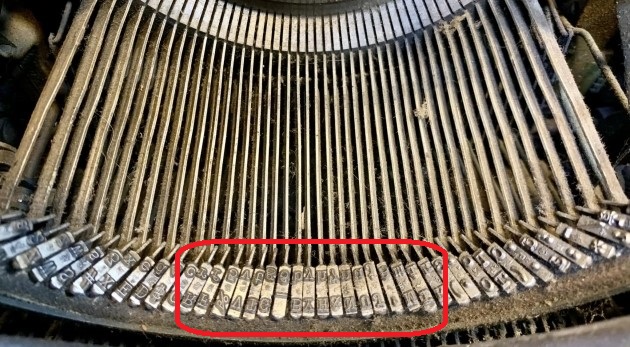
- OlivWriter
- Platen Punisher
 Offline
Offline - Registered: 23-2-2024
- Posts: 96
Detached slug solder...
Good morning
I noticed, after reassembling and cleaning everything, that one of the letters on the machine had unsoldered, so the slug no longer fits on the bar...
What do you suggest to me to reattach this slug to its bar?
THANKS
- OlivWriter
- Platen Punisher
 Offline
Offline - Registered: 23-2-2024
- Posts: 96
Re: Detached slug solder...
Illustrative image of my problem, but it is not unsoldered in the image, it is just to show the area because I am not on the terms of the first message...
- •
- robmck
- Speed Champion
 Offline
Offline - From: Seattle, WA
- Registered: 31-1-2022
- Posts: 389
Re: Detached slug solder...
Here's a video on soldering type slugs: Typewriter Soldering QWERTY Swap- Shim Method- Step by Step Tutorial (youtube.com)
Here's Mary at myoldtypweriter doing some soldering: Old Dog, New Tricks – myoldtypewriter
- thetypewriterman
- Key Master
 Offline
Offline - From: Leiston, England
- Registered: 29-5-2013
- Posts: 938
Re: Detached slug solder...
Never, never use silver solder as Mary has. The correct alloy is tin/lead. To be fair, she didn't realise.
- OlivWriter
- Platen Punisher
 Offline
Offline - Registered: 23-2-2024
- Posts: 96
Re: Detached slug solder...
And is it possible to only use tin for soldering ?
Because lead is toxic...
- •
- M. Höhne
- Key Master
 Offline
Offline - From: Maine
- Registered: 14-3-2013
- Posts: 644
Re: Detached slug solder...
thetypewriterman wrote:
Never, never use silver solder as Mary has. The correct alloy is tin/lead. To be fair, she didn't realise.
What is the problem with using silver solder for type slugs?
- thetypewriterman
- Key Master
 Offline
Offline - From: Leiston, England
- Registered: 29-5-2013
- Posts: 938
Re: Detached slug solder...
The problem with silver solder is that the joint has to be heated to red heat, thus destroying the temper of the spring steel typebar and potentially weakening it. If the type slug has slipped slightly during the process, it would be difficult to undo the joint and do it all over again. A soft-soldered joint is slightly elastic, thus acting as a shock absorber when the typeface hits the paper. A hard-soldered (silver solder joint) is not. Possibly you could use lead-free solder (tin), but I do not know if it has the same elasticity. Also, it does not have the same plasticity/temperature range as lead-based solder so may be more difficult to work with in this application. Finally, regarding lead being a poisonous metal - yes it is, but in the very small amounts being used it is hardly likely to cause you any problems. After all, until about ten years ago all the copper drinking water pipes in British homes were soldered together with tin/lead, and most still are. I don't think anyone ever died from it !
- SoucekFan
- Speed Champion
 Offline
Offline 
- From: United States
- Registered: 27-12-2015
- Posts: 499
Re: Detached slug solder...
thetypewriterman wrote:
The correct alloy is tin/lead.
Which variation of tin/lead solder would you recommend?
- thetypewriterman
- Key Master
 Offline
Offline - From: Leiston, England
- Registered: 29-5-2013
- Posts: 938
Re: Detached slug solder...
The correct material is 'tinmans solder', which is 40% tin, 60% lead. However, ordinary electronic solder, which is 60% tin, 40% lead will work just as well in practice.
- OlivWriter
- Platen Punisher
 Offline
Offline - Registered: 23-2-2024
- Posts: 96
Re: Detached slug solder...
Thank you for your answers ![]() .
.
And should I use a soldering iron or a blowtorch ?
- •

 1
1 